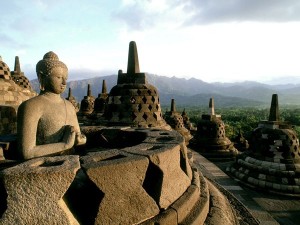 Indonesia Population 2013
Indonesia Population 2013
The current population of the Republic of Indonesia is 242.3 million people, which is about a 2% increase from the total population measured in the 2011 National Census of Indonesia. This population makes the country smaller than the Untied States of America, but larger than Japan. Based on the population and the area of the state, the population density of the country is about 329.5 people per square mile.
Indonesia Population Projections
Based on the estimates surrounding birth rates, death rates, and migration rates, by the year 2015, the population of Indonesia can expect to top 250 million as it reaches approximately 251.65 million people, which is an increase of about 3.9% from the current population. Then, by the year 2020, the population is projected to reach about 262.06 million people, an approximate 8.2% increase from the current population. Continuing this large growth, by 2025, the population is expected to reach 271.05 million people, an 11.9% increase in the population from the current total. From there, the population is projected to reach 278.53 million people in the year 2030, increasing at a rate of 15% from the current population. At this point, the population is expected to continue to increase, but at a decreasing rate. By 2035, the population will reach about 284.22 million people, about a 17.3% from the present population. Then, between 2035 and 2040, the population will only increase by a few million to 287.9 million, which is an increase of about 18.8% from today’s population. Again, the rate will slow down as the population reaches about 289.59 million by 2045, an increase of about 19.5%. But, by the year 2050, the population is expected to actually decrease by a few thousand to 289.45 million people.
Indonesia Land Mass
The Republic of Indonesia consists of approximately 13,667 islands, even though only about 6,000 are inhabited. Despite these 6,000 inhabited islands, there are five main islands: Sumatra, Java, Kalimantan, Sulawesi, and Irian Jaya. There are also two major archipelagos named Nusa Tenggara and the Maluku Islands. The country ranges from about 5,120 kilometers from east to west and 1,760 kilometers from north to south. The total land area of the country is about 1,919,317 square kilometers. The additional water area brings in about 93,000 square kilometers in inland seas, including straits and bays) and other surrounding sea areas. Together with the land and water, Indonesia makes up about 5 million square kilometers.
Indonesian Demographics
Of the approximate 242.3 million people in the Republic of Indonesia, about 40.6% of the population is Javanese. The next largest demographic in the country is Sundanese at about 15% of the population. The Madurese population of the country is about 3.3% of the population. The Minangkabau population makes up 2.7% of the total population. The Betawi and Bugis populations each make up about 2.4% of the total Indonesian population. The Banten population makes up about 2% of the population. Lastly, the smallest recognized demographic is the Banjar population, which makes up about 1.7% of the population. The rest of the population is noted as other or unspecified, making up about 29.9% of Indonesia.
Religion in Indonesia
Indonesia is not the type of country that has a state religion; however, there are certain categories that the beliefs/faith must belong to, otherwise those religions or faiths may not be practiced. The five categories are Islam, Buddhism, Roman Catholicism, Protestantism, and Hinduism. About 90% of the population of Indonesia practices the Islamic religion. The country is considered to be the largest Islamic country in the world. Because of this, it is deemed difficult to practice a religion other than Islam in Indonesia.
Indonesian Culture
The culture of Indonesia is one that is made up of over 300 ethnic groups, which brings little elements from each diverse culture to make up the one Indonesian culture. The Indian culture is what influenced the architecture in the country the most. The two most played sports in the country are badminton and football. Lastly, the food in Indonesia is influenced by the Chinese, Indian, Middle Eastern, and European culture. The main dish is rice with a side of meat and vegetables. The main spice in dishes is chili spice.
Indonesia Economy


